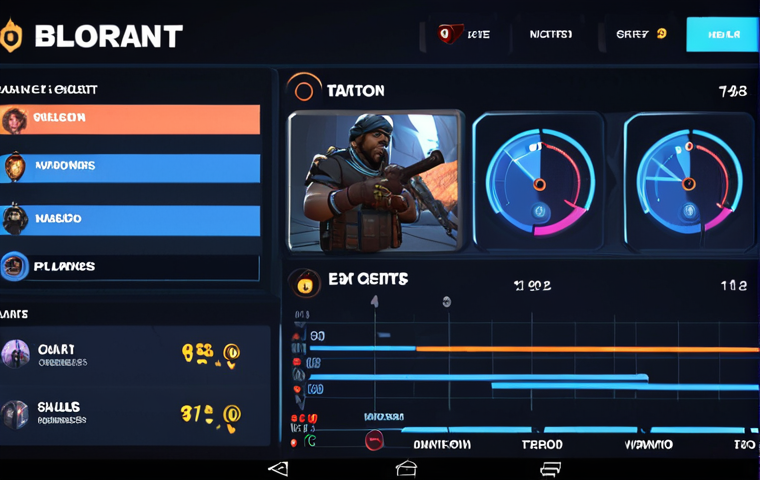Alright, here’s the blog-style intro about Valorant seasonal win rate changes, keeping all your instructions in mind:Valorant, much like any competitive game, is a constantly shifting landscape.
Each Act and Episode brings balance changes, new agents, and meta shifts that can dramatically impact which strategies and agents dominate. I’ve personally seen my own win rate fluctuate wildly from season to season, sometimes feeling like I can’t lose, and other times like I’m stuck in Elo hell.
It’s fascinating to see how Riot Games tweaks the formula and how the player base adapts. What starts as a seemingly minor adjustment can ripple through the entire game, influencing agent selection, map control, and even the way teams approach the economy.
It’s more than just shooting; it’s a constant chess match. Let’s delve deeper and get a precise look at how these seasonal shifts actually affect win rates!
The Evolving Agent Meta and Its Impact on Victory

The agent meta in Valorant is a volatile beast. One patch, a particular agent might be a must-pick, dominating both professional play and ranked queues.
The next, they might fall out of favor, replaced by a new, more effective strategy. I remember when Jett was the queen of the duelists – everyone wanted to play her, and her dash made her incredibly difficult to deal with, especially on maps like Ascent and Split.
Then, Chamber came along with his teleport ability, and suddenly, Jett wasn’t the only hyper-mobile threat. The introduction of new agents is huge, but smaller tweaks can also swing things dramatically.
Buffs to an agent’s abilities can make them viable, while nerfs can relegate them to the bottom tier. These changes force players to adapt, and it’s fascinating to watch how the community discovers new ways to utilize agents and create new team compositions.
It’s not just about individual skill; it’s about understanding the meta and knowing how to leverage your agent’s strengths within the current game state.
This dynamic nature ensures that Valorant never gets stale and that there’s always something new to learn and master. As a player, you have to stay informed, experiment with different agents, and be willing to adjust your playstyle to stay ahead of the curve.
The Rise and Fall of Specific Agents
It’s wild to see how specific agents can go from being universally loved to barely picked. Think about the Sage meta from back in the day – her healing and resurrection made her an auto-pick in almost every team composition.
Now, while she is still a useful choice, her pick rate has definitely decreased as other support agents like Skye and Fade have become more popular. This often comes down to subtle tweaks Riot makes to ability cooldowns, damage output, or even just changes to map layouts that favor certain agents over others.
These shifts can completely redefine how a team approaches a match and the agent compositions that are considered viable. I personally remember struggling to adapt when my favorite agent got nerfed, but it pushed me to explore other agents and ultimately broaden my skillset.
Community Perception Versus Actual Win Rates
Sometimes, there’s a disconnect between how the community perceives an agent and their actual win rate. An agent might be considered “weak” based on anecdotal evidence or because pro players aren’t using them as much, but their win rate in ranked play might be surprisingly high.
This can be because lower-ranked players haven’t fully mastered the strategies to counter that agent, or because the agent is particularly effective against certain team compositions that are common in ranked games.
It’s important to look at data and statistics, not just rely on opinions and trends, to truly understand an agent’s effectiveness.
Map Dynamics and Strategic Advantages
Valorant maps are intricately designed, and each one offers unique strategic advantages for different agents and playstyles. A map like Bind, with its tight corridors and teleporters, favors agents with strong close-range combat abilities and the ability to quickly rotate across the map.
On the other hand, a map like Breeze, with its long sightlines and open spaces, favors snipers and agents with long-range capabilities. The introduction of new maps and changes to existing maps can significantly impact the meta and shake up the game.
When Icebox first came out, everyone was struggling to figure out the best strategies for attacking and defending. It took time for the community to discover the optimal agent compositions and the best ways to control key areas of the map.
Some agents become almost essential on certain maps, while others become virtually unplayable. Understanding the map dynamics is crucial for maximizing your win rate and climbing the ranks.
Adapting to New Map Releases
When a new map drops, it’s like the wild west – nobody really knows what they’re doing. The first few weeks are a scramble as players experiment with different agents, try out different strategies, and try to figure out the best way to approach the map.
This is where you can really gain an edge by being proactive and learning the map inside and out. Watch videos, read guides, and, most importantly, play the map yourself to get a feel for its layout and dynamics.
Try out different agent compositions, experiment with different strategies, and find what works best for you.
Key Chokepoints and Control Zones
Each map has key chokepoints and control zones that are crucial for winning rounds. These are the areas where the fighting is most likely to happen, and controlling them can give your team a significant advantage.
For example, on Ascent, controlling mid is essential for both attacking and defending. If the attackers can control mid, they can easily rotate to either site, forcing the defenders to split their attention.
On the other hand, if the defenders can control mid, they can deny the attackers access to the sites and control the pace of the game.
Weaponry and Economy Swings
The economy in Valorant is a critical aspect of the game, and managing your credits wisely can be the difference between victory and defeat. Knowing when to save, when to buy, and which weapons to purchase is essential for maximizing your team’s chances of success.
Changes to weapon prices and stats can also have a significant impact on the meta. For instance, a slight increase in the price of the Operator can make it less viable, while a buff to the Spectre can make it a more attractive option on eco rounds.
These changes force players to re-evaluate their buying strategies and adapt to the new economic landscape.
Budgeting and Force Buys
Knowing when to eco, when to save, and when to force buy is a crucial skill in Valorant. Eco rounds are when your team saves money to buy better weapons and abilities in the following round.
Save rounds are when you buy minimal equipment to try to win the round without spending too much money. Force buys are when you spend all your money to buy the best possible equipment, even if it means leaving yourself with very little money in the following round.
Making the right decisions about when to use each of these strategies can give your team a significant advantage.
The Impact of Weapon Balance Patches
Riot Games is constantly tweaking weapon stats and prices to keep the game balanced. These changes can have a ripple effect throughout the game, impacting which weapons are most popular and how teams approach their buy strategies.
A small buff to a weapon’s damage or accuracy can make it much more viable, while a nerf can relegate it to the bottom of the barrel. Staying up-to-date on these changes is essential for staying competitive.
Individual Skill vs. Team Coordination
Valorant is a team-based game, and while individual skill is important, it’s not the only factor that determines your win rate. You could be the best aimer in the world, but if you’re not communicating with your team, coordinating your attacks, and playing strategically, you’re not going to win many games.
Team coordination is essential for success in Valorant, and it’s something that you can’t always control, especially when playing with random teammates.
That’s why it’s important to focus on the things that you can control, such as your own communication, your own teamwork, and your own strategic thinking.
The Role of Communication
Communication is key to success in Valorant. You need to be able to effectively communicate with your teammates about enemy positions, your own intentions, and the overall strategy for the round.
This means using voice chat to relay information quickly and clearly, and also using the game’s pinging system to mark enemy locations and points of interest.
Good communication can make a huge difference in the outcome of a round.
Synergy and Role Fulfillment
Having a team with good synergy and clear role assignments can greatly improve your chances of winning. Ideally, your team should have a mix of duelists, initiators, controllers, and sentinels, each fulfilling their specific role within the team.
Duelists are responsible for entry fragging and creating space for their team. Initiators are responsible for setting up their team for success with flashes, smokes, and other utility.
Controllers are responsible for controlling key areas of the map with smokes and other area-denial abilities. Sentinels are responsible for locking down sites and providing defensive support.
Here’s a table summarizing the impact of different factors on win rates:
| Factor | Impact on Win Rate | Example |
|---|---|---|
| Agent Meta | High | Dominance of Jett in early seasons vs. emergence of Chamber. |
| Map Dynamics | High | Bind favoring close-quarters combat vs. Breeze favoring snipers. |
| Weapon Economy | Medium | Strategic budgeting vs. force buys |
| Team Coordination | High | Effective communication and role fulfillment vs. lack thereof. |
| Individual Skill | Medium | Aimer vs Strategic thinking |
External Factors: Patches and Pro Play Influence
The world of Valorant doesn’t exist in a vacuum. External factors like patch updates and the strategies employed in professional play can have a significant influence on the solo queue experience.
A new patch can introduce balance changes that impact agent viability, weapon effectiveness, and map dynamics. Meanwhile, what works in pro play often trickles down to the rest of the player base as people try to emulate successful strategies.
But what works in a coordinated pro team doesn’t always translate effectively to the more chaotic environment of solo queue.
The ‘Pro Play’ Effect: Mimicking Strategies
Watching professional Valorant can be an excellent way to learn new strategies and improve your gameplay. However, it’s important to remember that pro teams operate on a different level than the average player.
They have dedicated coaches, analysts, and practice schedules, and they’re able to execute complex strategies with a level of coordination that’s simply not possible in solo queue.
Trying to mimic pro strategies without understanding the underlying principles can often backfire.
Balancing Act: Fun vs. Competitive Viability
Ultimately, Riot Games is trying to strike a balance between making Valorant a fun game and a competitive esport. This means making changes that keep the game fresh and exciting while also maintaining competitive integrity.
It’s not always easy to achieve this balance, and there are often disagreements within the community about whether certain changes are good for the game.
Some players prioritize fun and accessibility, while others prioritize competitiveness and skill expression.
Adapting Your Playstyle Season to Season
The only constant in Valorant is change. To maintain a high win rate, you need to be able to adapt your playstyle to the ever-evolving meta. This means staying informed about the latest patch notes, experimenting with new agents and strategies, and being willing to adjust your approach based on the map, your teammates, and the opposing team.
You might need to specialize an agent that becomes increasingly useful in certain scenarios.
Continuous Learning and Improvement
Valorant is a game that rewards continuous learning and improvement. The more you play, the more you’ll learn about the game’s mechanics, agent abilities, map layouts, and strategic nuances.
But it’s not enough just to play a lot; you also need to be actively trying to improve. Watch videos, read guides, analyze your own replays, and seek feedback from other players.
Experimentation and Flexibility
Don’t be afraid to experiment with new agents, weapons, and strategies. The meta is constantly evolving, and what works today might not work tomorrow.
Be willing to step outside of your comfort zone and try new things. You might be surprised at what you discover. And most importantly, be flexible and adaptable.
Be prepared to adjust your strategy based on the situation, and don’t be afraid to switch agents if your current agent isn’t working. The agent meta in Valorant is a constantly shifting landscape, influenced by everything from patch updates and map releases to professional play and community perception.
To climb the ranks and stay ahead of the curve, it’s essential to stay informed, adapt your playstyle, and focus on teamwork and communication. Remember, Valorant is a team game, and even the best aimer in the world can’t carry a team alone.
By understanding the dynamics of the agent meta, map design, economy, and team coordination, you can significantly improve your chances of success in Valorant.
It’s not just about individual skill; it’s about understanding the game and playing smart.
In Conclusion
Navigating the ever-changing Valorant meta can feel like a daunting task, but by embracing continuous learning and adaptability, you’ll find yourself well-equipped to handle any challenge. Remember, success in Valorant isn’t just about individual skill; it’s about understanding the nuances of the game and working effectively with your team. Keep experimenting, stay informed, and never stop striving to improve.
Whether it’s mastering a new agent or fine-tuning your communication skills, every step you take will bring you closer to achieving your goals. So, dive in, have fun, and let the pursuit of victory fuel your journey.
And remember, even the pros started somewhere. Every match is a learning opportunity, and with dedication and a positive attitude, you can reach new heights in Valorant!
Handy Tips
1. Warm-up Routines: Before diving into competitive matches, spend some time in the practice range or deathmatch to get your aim and reflexes sharp. A consistent warm-up routine can make a noticeable difference in your performance.
2. Crosshair Placement: Focus on maintaining proper crosshair placement at head level. This will significantly improve your chances of securing quick and efficient kills. Practice predicting enemy positions and adjusting your crosshair accordingly.
3. Sound Awareness: Pay close attention to audio cues such as footsteps, reloads, and ability usage. Sound awareness can provide valuable information about enemy locations and movements, allowing you to make informed decisions.
4. Effective Communication: Use clear and concise communication to relay information to your teammates. Call out enemy positions, rotations, and utility usage. Positive and supportive communication can boost team morale and improve coordination.
5. VOD Review: Review your own gameplay footage to identify areas for improvement. Analyze your decision-making, aim mechanics, and positioning. Learning from your mistakes is crucial for long-term growth.
Key Takeaways
Agent Selection Matters: Always consider the map and team composition when choosing your agent.
Map Knowledge is Crucial: Learn the callouts, angles, and key positions on each map.
Economy Management: Master the art of eco rounds, force buys, and smart spending.
Teamwork Makes the Dream Work: Communicate effectively and play your role within the team.
Adapt and Overcome: Be flexible and willing to adjust your strategy based on the situation.
Frequently Asked Questions (FAQ) 📖
Q: How often does Valorant’s meta actually change, and does it significantly affect my win rate?
A: Valorant’s meta is surprisingly dynamic. Riot Games rolls out patches roughly every two weeks, with larger balance updates coinciding with new Acts (about every two months) and Episodes (roughly every six months).
These updates can introduce new agents, tweak existing abilities, and adjust weapon stats. In my experience, these changes absolutely influence win rates.
I’ve had agents I main suddenly become less viable, forcing me to adapt or risk losing more games. Staying informed about patch notes and practicing with different agents and team compositions is crucial for maintaining a consistent win rate.
Q: I’m stuck in a rank and my win rate is consistently low. What specific steps can I take to improve?
A: Been there! Getting stuck in a rank is frustrating, but it’s a common experience. First, focus on self-improvement.
Record your gameplay and analyze your mistakes. Are you consistently missing shots? Is your map awareness lacking?
Are you communicating effectively with your team? Practice your aim in the range or in deathmatch. Watch professional Valorant players and analyze their strategies.
Next, consider your agent pool. Are you flexible enough to play different roles, or are you always defaulting to the same agent? Finally, focus on your mental game.
Tilt is real! Take breaks when you’re feeling frustrated and remember that every game is a learning opportunity. Also, positive communication and teamwork can drastically improve your chances of winning, even if your individual skill isn’t the highest.
Q: How much does team composition affect win rates in Valorant, and what are some generally good team compositions to aim for?
A: Team composition is HUGE. I’ve seen so many games thrown because people pick five Duelists or refuse to play a Controller. Ideally, you want a balanced team that covers different roles.
A solid comp usually includes at least one Controller (for smoking off areas), one Initiator (for pushing sites and gathering intel), one Sentinel (for defense and area denial), and then a mix of Duelists and Flex agents to provide firepower and adaptability.
Of course, the best comp also depends on the map and your team’s playstyle, but a balanced approach will generally give you a much higher chance of success.
Don’t be afraid to fill roles your team needs, even if it’s not your preferred agent. A cohesive team is almost always stronger than a team of individual superstars.
📚 References
Wikipedia Encyclopedia
구글 검색 결과
구글 검색 결과
구글 검색 결과
구글 검색 결과






